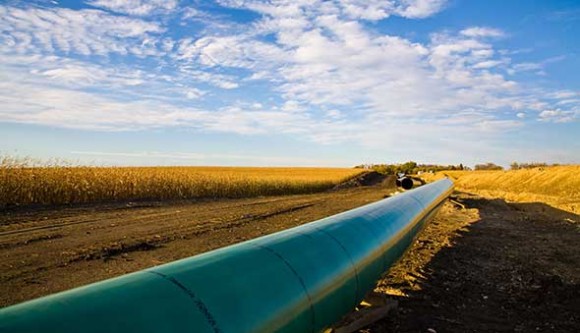
The system built to manage Russia’s nuclear legacy is crumbling, our new report shows
Our op-ed originally appeared in The Moscow Times. For more than three decades, Russia has been burdened with the remains of the Soviet ...
News

Publish date: January 24, 2017
News
In his first strike against the last administration’s environmental legacy, President Donald Trump signed orders clearing the way for building two oil pipelines shelved by Barack Obama, the Keystone XL and the Dakota Access.
How the order Trump signed Tuesday will advance either project remains unclear, as the environmental policies undergirding their rejection by Obama are buttressed by legislation.
But the symbolism of testing what Trump called an “incredibly cumbersome, long, horrible permitting process” was clear.
It was an expected move. Within an hour of Trump’s inauguration on Friday, all mention of climate change on the White House website was purged and replaced with the “America First Energy Plan,” a populist tract on jettisoning environmental regulation to tap US shale gas and oil reserves.
Further, Trump has held up to $1 million in stock in Energy Transfer Partners, the company building the 1,880-kilometer Dakota Access pipeline. He reportedly sold most of the shares in December, but the company’s CEO, Kelcy Warren, was a major contributor to Trump’s campaign.
Trump is intent on advancing America’s fossil fuel interests abroad as well. Rex Tillerson, the former ExxonMobil CEO with ties to Vladimir Putin, was Monday confirmed by the Republican-dominated senate.
A $500 billion oil deal that would divide the Arctic between ExxonMobil and Russia’s state driller Rosneft, was put on ice by US sanctions in 2014 – sanctions Trump, in his admiration for Putin, has signaled he’s likely willing to repeal.
Before and since taking office, Trump has denied that his enormous business ties would conflict with any decision he makes as president. But his continued pushback against releasing his tax returns – something every US president since Richard Nixon has done – make that claim impossible to verify. Because of that, Trump’s decisions on environmental matters might be driven by prospects for his own personal financial gain.
Later in the day, officials from the Environmental Protection Agency sneaked news out under a White House imposed Twitter and social media gag that its grants and contracts for toxic cleanups, water cleanup and other necessary operations had been frozen. The EPA and other agencies dealing with the environment and climate science were told to cease communicating with the public. The ban drove Badlands National Park to go rogue and Tweet facts about climate change until its plug was pulled, too.
The climate tweets were then deleted.
Obama rejected the Keystone XL pipeline in the run up to the Paris Climate talks in 2015, arguing that its construction would undermine US leadership in curbing reliance on fossil fuels. The 1,897 km pipeline would run from Hardesty in Alberta, Canada through several US states to Nederland, Texas on the Louisiana border.
And last month, thousands of protestors that had camped out for months to oppose the route of the Dakota Access pipeline over Native American tribal lands scored a victory when the Army Corps of Engineers said it would study alternative routes.
The Keystone XL pipeline, especially, became a gauntlet between American energy appetites and the White House’s commitment to stem a fatal build up of greenhouse gases. The magazine Scientific American said the pipeline would move enough tar sands to pump 181 million metric tons of greenhouse gases into the atmosphere each year, or an amount equal to the pollution put out by 37.7 million cars.
After agonizing over the pipeline his first term and part of his second, Obama killed it as part of the US investment in the Paris Agreement.
In North Dakota, the Dakota Access became a historically pregnant standoff between the federal government and the Standing Rock Sioux tribe, who easily view the pipeline as a land grab that further threatens their drinking water.
On Tuesday, Trump touted both pipeline projects as job creators and ways to shore up US energy. But oil analysts have said neither project will lead to a significant number of permanent positions or contribute much to American oil and gas reserves.
The Keystone XL, particularly, would carry climate-volatile tar sands gas to refineries in Texas for export abroad, bypassing the US market entirely.
But Trump’s photo op position on Tuesday had nothing to do with that. Instead, his focus was on continuing the pipeline projects with American made steel – like, he said, “we used to in the old days.”
Whether TransCanda, the company planning to build the Keystone XL, would acquiesce to that is also in question.
TransCanada had planned to get about 65 percent of the steel pipe from US manufacturers, but other supplies from Canada. Trump has pledged to renegotiate that deal.
Environmentalists, who, in North Dakota, have endured tear gas, flash grenades, fire hoses and rubber bullets, have vowed to renew protests. Trump’s America First Energy Policy doesn’t provide for any negotiations with them.

Our op-ed originally appeared in The Moscow Times. For more than three decades, Russia has been burdened with the remains of the Soviet ...

The United Nation’s COP30 global climate negotiations in Belém, Brazil ended this weekend with a watered-down resolution that failed to halt deforest...

For more than a week now — beginning September 23 — the Zaporizhzhia Nuclear Power Plant (ZNPP) has remained disconnected from Ukraine’s national pow...

Bellona has taken part in preparing the The World Nuclear Industry Status Report 2025 and will participate in the report’s global launch in Rome on September 22nd.